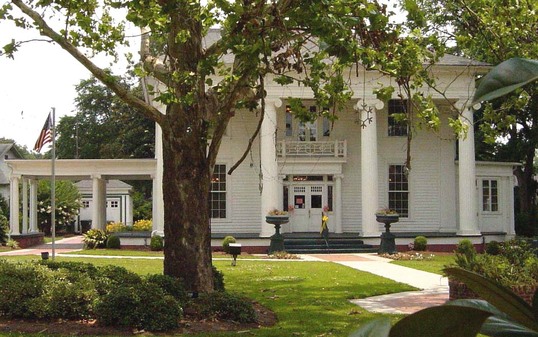|
|
Architectural Information
The Troutman House is an example of Vernacular Greek Revival, a style prevalent in many towns of Georgia and the South between 1820 and 1860. This style is called Vernacular Greek Revival because, unlike pure Greek Revival, it includes square columns as well as the authentic Greek round columns of antiquity. The Smith House in Sparta with its 18 foot Corinthian columns each on a six-foot square Doric columns is a classic example of Venerable Greek Revival.
The front of the house has four round Corinthian columns on a full-facade porch. The plain crowns on windows of 48 panes identifies it immediately as Greek revival, while the square bases of the wall Corinthian columns on the house identify it as Vernacular Greek Revival. This does not subtract from its authenticity: approximately 40 percent of surviving Greek revival houses are estimated to be vernacular.
Above each column, between the roof and column, a unique design is added. The decorative trim immediately beneath the roof was frequently used in Greek revival.
The recessed front entrance with full transom light and half sidelights is framed by round Corinthian columns supporting a plain crown, giving a three dimensional effect. The two carved designs at the comers above each column is repeated elsewhere on the house.
The second story balcony is pure Greek revival, with double doors of eight panes each, double transoms of 12 panes each and a traditional railing of Greek design.
The porte-cochere with four round Corinthian columns, three full square Doric columns and two square Corinthian wall columns is probably part of the original but the three square columns were probably added later for stability. It has a flat roof typical of Greek revival extensions. The carriage house has the same square Doric columns with similar low-pitched hipped roof and square windowpanes. An architect who knew the style and the importance of detail evidently built it.
The horizontal window of the side entrance mirrors the horizontal window on the Southwest side. Several combinations of square window panes are used throughout: three horizontal panes and four vertical panes on the front downstairs, 3/4 second floor front, 3/6, even 7/3 for horizontal windows. Two matching planters are placed at each end of the bay window. The twin planters at the front steps are reminiscent of the small boxwoods frequently highlighting this style.
The sunroom on the South side of the front was added after the house was built, judging from the outside doorway and the weatherboard on the inside wall. But it is extremely well done. It has Doric Square columns with large square windowpanes. The design above the columns is the same as that at the entrance comers -obviously carved for the addition. Also, it is too close to the square bay window that extends two floors immediately behind it to have been original. The attractive room features windows on three sides.

